For enlargement: PASTORAL ASSIGNMENTS 2019
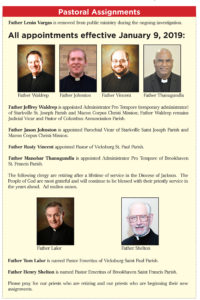
For enlargement: PASTORAL ASSIGNMENTS 2019

JACKSON – Emanuele Fontanini, a fourth-generation member of the family now famous for their detailed nativity sets, spent a couple of hours at the Carmelite monastary on Saturday, Dec. 1. The tour is part of Fontanini Nativity’s 110th anniversary. The artist signed figuries and visited with collectors. The Carmelites have carried the Fontanini collection in their gift shop for generations and even keep a registry for families who purchase a new figurine annually. (Photo by Tereza Ma)
By Maureen Smith
JACKSON – This year’s iGiveCatholic one-day online giving campaign raised more than $5.6 million from 23,000 donors across the United States. The Diocese of Jackson raised $72,521 for parishes, schools and organizations.
This is the third year the diocese has participated in iGiveCatholic. Organizers sought to take advantage of a national philanthropy effort called Giving Tuesday, which falls on the Tuesday after Thanksgiving as a charitable counterpart to the consumerism of Black Friday and Cyber Monday. More dioceses have joined every year, making it a truly national effort. “It was so awesome to be join with other dioceses around the country. It helps us show our communities all the wonderful work Catholics are doing in our dioceses, said Rebecca Harris, executive director of The Catholic Foundation for the Diocese of Jackson. The foundation covers the cost of participating so parishes and schools can keep all the money they raise.
The idea is simple, iGiveCatholic provides an online giving platform for parishes, schools and diocesan-sponsored organizations. Those who choose to participate select a particular project they want to fund. The organizations can promote the projects however they want. Many use videos, social media or internal community communications to raise awareness about their effort. Then, on Tuesday, Nov. 27, the website accepts donations for 24 hours.
This year’s top earner was the Carmelite Monastery in Jackson. The sisters need a new heating and air conditioning system at the monastery. “Most of us got sick last year because we had no A/C, we had no heat,” explained prioress Sister Jane Agonoy, OCD. They now have $17,000 to put toward the project. This is a good start, but will not pay for the whole system. “We go by faith, but proceeds were good enough to get started. We told them to start with where the sisters live.
The rest will just follow,” she added.
Sister Jane said she wants to thank all their benefactors from her heart. She believes the Sisters were successful in part because of efforts this year to raise awareness about the community and in part because people appreciate their work. “They can feel our prayers. Our benefactors might never see us in person, but they can feel our prayers. We really, really pray for them. We gather as a community seven times a day to pray the prayer of the church. It is our life. It is a sacrifice, but we do it for love,” she added. The Sisters also need to replace a collapsing brick wall around their property, but Sister Jane has faith that that project will also be completed.
Diocesan schools did well during the campaign. Jackson St. Richard came close to raising $10,000 to improve technology. Madison St. Joseph School will put $9,000 toward a new bus. Madison St. Anthony raised almost $7,500 and Jackson Sister Thea Bowman School raised almost $6,000.
“IGiveCatholic is a fun way for everyone in the Diocese of Jackson to feel connected. Following the leaderboard and watching the numbers climb is very exciting,” said Jennifer David, principal at St. Richard. She said their project falls in line with other improvements at the school. “Their generous gifts will make it possible to continue implementing our newly revised technology plan. We want St. Richard students to have access to cutting-edge technology as a way to enjoy and enrich their learning,” David added.
St. Joseph School principal Dena Kinsey said a bus will help both the students under her roof and those who may have siblings at other schools.“A school bus would allow us to shuttle students to school in the morning from Jackson, for families who find the commute to St. Joe a hardship. Our students are involved in many activities. A bus would provide transport to retreats, enable our fine arts students to perform at local elementary schools and nursing homes, take students to visit children at Blair E. Batson hospital, to away games for athletics and other activities,” she added.
Kinsey appreciates that the effort is elevated beyond the diocese. “I appreciate that IGiveCatholic is a national campaign which utilizes Giving Tuesday as a platform to come together as faithful stewards towards a specific goal, connecting with our current donors, and giving us the opportunity to build relationships with new supporters,” she explained.
Vicksburg Catholic School used videos to promote its project – a new awning to keep students dry when they leave St. Francis Xavier elementary on rainy days. “We have been talking about an awning for years,” said Kristi Smith, development director. Other needs, she said, would always take precedence. IGiveCatholic gave the school an opportunity to earmark money specifically for the project.
“We started piecing together those videos a couple of weeks ago when we were having torrential rains,” explained
Kristi Smith, development director. The kids sang their own version of ‘Raindrops keep falling on my head’ in the promotional video on the school’s iGiveCatholic page. On Nov. 27, the school posted other photos and videos on its social media pages to encourage people to donate. Thanks to donors, the project is 61 percent funded. The school may utilize the videos and shoot some new ones as they continue their effort to raise the remaining money needed.
Parish projects included wireless internet access for Madison St. Francis Parish and rectory roof repairs at the Cathedral of St. Peter the Apostle.
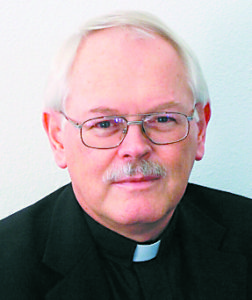
Father Ron Rolheiser, OMI
IN EXILE
By Father Ron Rolheiser, OMI
When is our life fulfilled? At what point in our lives do we say: “That’s it! That’s the climax! Nothing I can do from now on will outdo this. I’ve given what I have to give.”
When can we say this? After we’ve reached the peak of our physical health and strength? After giving birth to a child? After successfully raising our children? After we’ve published a best-seller? After we’re famous? After we’ve won a major championship? After we’re celebrated the 60th anniversary of our marriage? After we’ve found a soulmate? After we’re at peace after a long struggle with grief? When is it finally done? When has our growth reached its furthest place?
The medieval mystic, John of the Cross, says we reach this point in our lives when we have grown to what he calls “our deepest center.” But he doesn’t conceive of this the way we commonly picture it, namely, as the deepest center inside our soul. Rather, for John, our deepest center is the optimum point of our human growth, that is, the deepest maturity we can grow to before we begin to die. If this is true, then for a flower, its deepest center, its ultimate point of growth, would be not its bloom but the giving of its seed as it dies. That’s its further point of growth, its ultimate accomplishment.
What’s our ultimate point of growth? I suspect that we tend to think of this in terms of some concrete, positive accomplishment, like a successful career or some athletic, intellectual, or artistic achievement that’s brought us satisfaction, recognition, and popularity. Or, looked at from the point of view of depth of meaning, we might answer the question differently by saying that our ultimate achievement was a life-giving marriage, or being a good parent, or living a life that served others.
When, like a flower, do we give off our seed? Henri Nouwen suggests that people will answer this very differently: “For some it is when they are enjoying the full light of popularity; for others, when they have been totally forgotten; for some, when they have reached the peak of their strength; for others, when they feel powerless and weak; for some it is when their creativity is in full bloom, for others, when they have lost all confidence in their potential.”
When did Jesus give off his seed, the fullness of his spirit? For Jesus, it wasn’t immediately after his miracles when the crowds stood in awe, and it wasn’t after he had just walked on water, and it wasn’t when his popularity reached the point where his contemporaries wanted to make him king that he felt he had accomplished his purpose in life and that people began to be touched in their souls by his spirit. None of these. When did Jesus have nothing further to achieve?
It’s worth quoting Henri Nouwen again, in answering this question: “We know one thing, however, for the Son of Man the wheel stopped when he had lost everything: his power to speak and to heal, his sense of success and influence, his disciples and friends – even his God. When he was nailed against a tree, robbed of all human dignity, he knew that he had aged enough, and said: ‘It is fulfilled’ (John 19, 30).”
“It is fulfilled!” The Greek word here is Tetelesti. This was an expression used by artists to signify that a work was completely finished and that nothing more could be added to it. It was also used to express that something was complete. For example, Tetelesti was stamped on a document of charges against a criminal after he had served his full prison sentence; it was used by banks when a debt had been repaid; it was used by a servant to inform his master that a work had been completed; and it was used by athletes when, tired and exhausted, they successfully crossed the finish line in a race.
It is finished! A flower dies to give off its seed so it’s appropriate that these were Jesus’ last words. On the cross, faithful to the end, to his God, to his word, to the love he preached, and to his own integrity, he stopped living and began dying, and that’s when he gave off his seed and that’s when his spirit began to permeate the world. He had reached his deepest center, his life was fulfilled.
When does our living stop and our dying begin? When do we move from being in bloom to giving off our seed? Superficially, of course, it’s when our health, strength, popularity, and attractiveness begin to wane and we start to fade out, into the margins, and eventually into the sunset. But when this is seen in the light of Jesus’ life, we see that in our fading out, like a flower long past its bloom, we begin to give off something of more value than the attractiveness of the bloom. That’s when we can say: “It is fulfilled!”
(Oblate Father Ron Rolheiser, theologian, teacher and award-winning author, is President of the Oblate School of Theology in San Antonio, TX.)
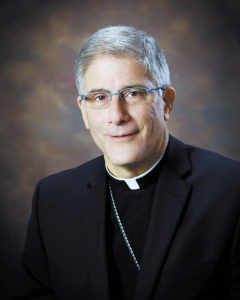
Obispo Joseph R. Kopacz
Por Obispo Joseph Kopacz
Los ujieres del Adviento anuncian el comienzo de un nuevo año de la Iglesia y llaman a los discípulos del Señor a preparar su camino para la venida del Reino, uno de justicia y paz y la alegría del Espíritu Santo, (Romanos). La fe en el Único que Dios envió, el camino a la vida, porque fe es “plena seguridad de recibir lo que se espera; es estar convencidos de la realidad de cosas que no vemos”, (Hebreos, 11,1).
La Palabra de Dios en Adviento trata sobre el llamado a la santidad y la vida justa para los individuos, pero también exige la eliminación de estructuras y realidades pecaminosas en medio de nosotros que son obstáculos para el Reino de Dios en la tierra.
Juan el Bautista representa a cada generación de profetas en anticipación al Mesías que tuvo esta visión, porque él es la voz de uno que grita en el desierto: “Preparen el camino del Señor, ábranle un camino recto. Todo valle será rellenado, todo cerro y colina será nivelado, los caminos torcidos serán enderezados, y allanados los caminos disparejos. Todo el mundo verá la salvación que Dios envía”, (Lucas 3,5-6).
En el segundo domingo de Adviento estas palabras de Isaías son abrazadas por Juan el Bautista, al señalar al tan esperado Mesías, el Cordero de Dios, que reunirá a todas las naciones en la paz del Reino de Dios.
Sin embargo, no puede haber una paz duradera sin justicia, y las palabras de los cuatro profetas de Israel presentadas durante el Adviento lo dejan muy claro. En el segundo domingo de Adviento, el profeta Baruc, proclama implacablemente a viva voz: “Jerusalén, quítate la túnica del luto y la miseria; vístete de gala con el esplendor de la gloria de Dios para siempre, envuelto en el manto de la justicia de Dios … Dios está guiando a Israel con alegría por la luz de su gloria, con su misericordia y justicia por compañía. “(Baruch 5,1-2, 8 -9)
Este es mi anhelo y esperanza para la Diócesis de Jackson y especialmente para las comunidades parroquiales de Saint Joseph en Starkville y Corpus Christi en Macon. Que el Señor Jesús expulse las nubes de luto y miseria y nos guíe a la luz de su gloria con misericordia y justicia por compañía. Qué gran regalo será este para todos los que buscamos preparar su camino en nuestras vidas.
El primer domingo de Adviento, la semana pasada, colocamos en los boletines parroquiales de San José y Corpus Christi un llamado que pide por una justicia restaurativa y reconciliación para todos los que sufren en estas comunidades parroquiales. La justicia requiere que a todos los que sinceramente donaron a las causas de salud y / o misión del Padre Lenin Vargas, causas que durante varios años hizo sin la supervisión diocesana, se les debe ofrecer la oportunidad de una restauración financiera y material. Esto está en marcha. Sin embargo, solo la fuerza que viene de Dios puede remediar el profundo sentimiento de luto y desdicha que pesa sobre los corazones, las mentes y las almas de muchos de los fieles, monetariamente afectados o no.
Oramos para que la temporada de Adviento sea un tiempo de reconciliación y renovación. Hemos programado un servicio de Reconciliación en Saint Joseph, para las dos comunidades parroquiales, el miércoles 19 de diciembre para orar que la gracia salvadora de Dios nivele las montañas de luto y llene los valles vacíos que abruman actualmente a nuestros corazones.
La esperanza y la alegría de la Navidad están arraigadas en la convicción de que nada es imposible para nuestro Dios que viene a salvarnos y oro, junto con muchos otros de buena voluntad, que las semillas de la sanación y la nueva vida ya están echando raíces porque el Señor está cerca, en cada rincón de nuestras mentes y corazones y en cada rincón de la Diócesis de Jackson.
Maranatha, ven, Señor Jesús.

Bishop Joseph R. Kopacz
By Bishop Joseph Kopacz
Advent ushers in the new Church year calling the Lord’s disciples to prepare his way for the coming of the Kingdom, one of justice and peace and the joy of the Holy Spirit. (Romans) Faith in the One God sent is the road to life, because it is “the substance of things hoped for, the evidence of things not seen.” The Word of God in Advent addresses the call to holiness and righteous living for the individual, but also calls for the removal of sinful structures and realities in our midst that are obstacles to God’s Kingdom on earth.
John the Baptist represents every generation of prophets in anticipation of the Messiah who had this vision, for he is the voice of one crying out in the desert: “Prepare the way of the Lord, make straight his paths. Every valley shall be filled and every mountain and hill shall be made low. The winding roads shall be made straight and the rough ways made smooth and all flesh shall see the salvation of God.” (Luke 3,5-6) On the second Sunday in Advent, these words of Isaiah, embraced by John the Baptist, point to the long-awaited Messiah, the Lamb of God who will gather all nations into the peace of God’s Kingdom.
Yet, there can be no lasting peace without justice and the words of the four prophets of Israel featured during Advent make this abundantly clear. On the second Sunday in Advent the prophet Baruch full-throated and unsparingly proclaims: “Jerusalem, take off your robe of mourning and misery; put on the splendor of glory from God forever, wrapped in the cloak of justice from God… God is leading Israel in joy by the light of his glory, with his mercy and justice for company.” (Baruch 5,1-2, 8-9) This is my longing and hope for the Diocese of Jackson and especially for the parish communities of Saint Joseph in Starkville and Corpus Christi in Macon. Let the Lord Jesus banish the clouds of mourning and misery and guide us in the light of his glory with mercy and justice for company. What a great gift this will be for all of us who seek to prepare His way in our lives.
On the First Sunday in Advent last week we placed an insert in the parish bulletins of Saint Joseph and Corpus Christi that calls for restorative justice and reconciliation for all who are suffering in these parish communities. Justice requires that everyone who sincerely gave to Father Lenin Vargas’ causes for health and/or mission, causes, not done with diocesan oversight for a number of years, must be offered the opportunity for financial and material restoration. This is underway.
However, only the strength that comes from God can remedy the profound sense of mourning and misery that weigh down the hearts, minds and souls of many of the faithful, financially deprived or not. We pray that the season of Advent will be a time of reconciliation and renewal and we have scheduled a Reconciliation Service at Saint Joseph’s for the two parish communities on Wednesday, December 19, to pray that God’s saving grace may level mountains of mourning and fill the valleys of emptiness presently overwhelming our hearts.
The hope and joy of Christmas are rooted in the conviction that nothing is impossible for our God who comes to save us and I pray, along with many others of good will, that the seeds of healing and new life are already taking root because the Lord is near, in every corner of our hearts and minds and in every corner of the Diocese of Jackson. Maranatha, Come, Lord Jesus.
By Gene Buglewicz
OXFORD – Knights of Columbus Council 10901, based out of St. John the Evangelist Parish, participated in the international devotional and pilgrimage to Our Lady of Guadalupe, the Patroness of North America in late September. James Reid, trustee for the council, coordinated with other councils as well as the devotional which begins with recitation of the rosary and includes displaying a silver rose.
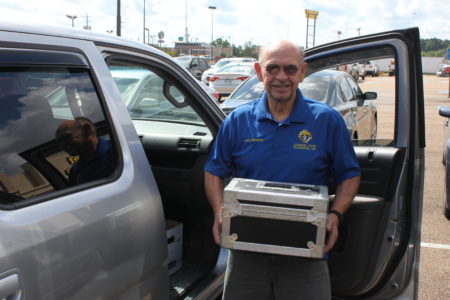
CLINTON – Larry Moeller, from Council 10216, Flowood, receives the traveling case that carries the silver rose carried by Gene Buglewicz, Council 10901, Oxford. Council 10216 was having their devotional honoring Our Lady of Guadalupe later that afternoon. After Council 10216’s devotional, a representative will again carry the silver rose to yet another Council for their devotional, and so on until the silver rose reaches the end of it’s journey at the Shrine of Our Lady of Guadalupe in Monterrey Mexico in early December. (Photo by Gene Buglewicz)
At the conclusion of the program, the silver rose was packed in its special transport box, and staying within the custom of the rose not remaining in one location for more than 24 hours, was given to council member Gene Buglewicz who was traveling to Clinton the next morning. There the silver rose was passed to Larry Moeller of Council 10216 who was taking the rose to it’s next devotional location.
Interestingly, Larry Moeller and Gene Buglewicz were friends and neighbors from Vicksburg and had not seen each other for at least 10 years. Both had been members of Knights of Columbus Council 898 in Vicksburg. Both Larry and his wife had moved to Flowood and Gene and his wife had moved to Water Valley, so they had not seen each other for some time. After catching up on family and friends, Larry departed the parking lot to deliver the silver rose to his council and Gene and his wife departed for Water Valley.
As the silver roses pass from council to council on their journey throughout the United States, Canada and Mexico, this scene is repeated over and over again as old friends from different councils and bound by the Knights of Columbus and brotherhood, sometimes from different countries, meet to pass on a representation of our common faith and adoration of Our Lady of Guadalupe to commemorate the miracle of the silver rose.
Council 10901 is proud to play a part in the this international devotional to Our Lady of Guadalupe.
(Gene Buglewicz is a member of Oxford St. John Parish.)
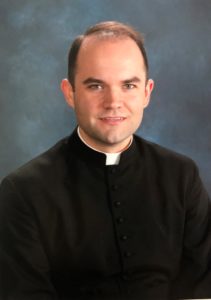
Father Aaron Williams
SPIRIT AND TRUTH
By Father Aaron Williams
The Advent season is one of my favorite seasons of the year — mainly because of the texts used in the liturgy during this time of expectation and hope. One of my favorite lines in the breviary during this season comes on the Second Sunday of Advent. “The Lord will surely come and will not be late; if he seems to delay, wait for him.” Another ancient text for Advent speaks of looking to Christ coming on the last day. “I look from afar: and lo, I see the power of God coming and a cloud covering the whole earth.”
Advent has always been a time of double-expectation. On one hand, we are expectant of the birth of Christ on Christmas day. But, on the other we are hopeful for the final return of our Lord in the end. Of that day, Christ says, “Just as lightning comes from the east and flashes as far as the west, so will be the coming of the Son of Man.” Christian tradition has always associated the East with the coming of Christ. We can even make a simile of it: Christ the Rising Son will come as the rising of the sun.
For this reason, Christian worship from ancient times was even oriented physically towards the east. Many of our Churches are built so that the faithful face East in their pews. Old Catholic cemeteries were often designed so that the grave plots faced East — giving a sign that even the dead remain hopeful for the return of Christ. For the majority of liturgical history, Catholic worship was always totally oriented towards the East with even the priest facing towards the rear wall of the Church where there was an image of Christ displayed — both priest and faithful looking hopefully towards Christ.
In the reformed liturgy, room was given in the new missal to allow priests to begin celebrating the Mass facing the people. This became popular throughout the world, and with the exception of some chapels and churches without free-standing altars, has nearly become the entirely universal practice in the Roman Church today. It is worth mentioning, however, that even in the modern form of the Mass where such a face-to-face orientation is allowed (and common), Eastward celebration by the celebrant was never outlawed. On the contrary, even the modern Roman Missal assumes this orientation and gives directions to the priest as to when he should momentarily turn around at various points in the Mass in order to address the faithful behind him.
In fact, in recent years, some high-ranking officials in the Church, including Robert Cardinal Sarah — the head of the Vatican’s own liturgy office — have encouraged priests to reconsider this ancient posture. Even the former chairman of the U.S. Bishop’s office of Divine Worship, Bishop Arthur Serratelli, wrote a letter to all the bishops of the United States last year where he underscored that this was a legitimate option even in today’s liturgy, though adding that such a decision should take into account the spirit of the parish and the vision of the bishop in his own diocese. In other Christian liturgical rites (such as the Eastern/Greek liturgy), Eastward orientation is still the assumed and required posture.
So, while I would certainly underscore Bishop Serratelli’s comment regarding the pastoral considerations such a decision should require, it is helpful to look upon this ancient custom with a true understanding of its meaning. Regrettably, most people associate this posture with a sort of “clerical” understanding of the Church, where priests are disinterested with he faithful and thus approach the Mass with their “backs facing them.” But, this is not a helpful perspective on our own rich liturgical history, which is far more rooted in theological ideas than such base considerations.
For our own purposes, perhaps during this Advent season we can encourage a spirit of “Eastward worship” in our own homes by making sure there is a dedicated focus for prayer — a crucifix or a holy image. Families can gather and pray together before these images, and remain hopeful for the coming of Christ the Lord in all his glory.
(Father Aaron Williams is the parochial vicar at Greenville St. Joseph Parish and serves as the liaison to seminarians for the Office of Vocations.)
GALLMAN – The Diocesan Fall Search Retreat took place November 9-11, at Camp Wesley Pines. sixty-five juniors and seniors from across the diocese participated in the weekend retreat either as Searchers or Staffers.
Search is unique in that it is a retreat “for teens; led by teens.” Modeled after the Cursillo movement, search has been an active ministry for youth in our diocese for the last 15 years. The retreat is sponsored by the Diocesan Office of Youth Ministry but St. Richard parishioners, Ann and Jeff Cook have been the longtime volunteer adult coordinators
The Spring Search Retreat is set for March 1-3, 2019 at Camp Wesley Pines. Juniors and Seniors can register for the retreat via www.jacksonsearch.com. Space is limited. For questions, please contact Abbey Schuhmann in the Office of Youth Ministry – Abbey.Schuhmann@jacksondiocese.org or (601)949-6934.
COLUMBUS – Annunciation sixth-grade students presented the Hall of Saints on Friday, November 2. Each student researched a saint for several months and then portrayed that saint, complete with costumes and props, while telling interesting facts about them to the younger students. (Photo by Katie Fenstermacher)